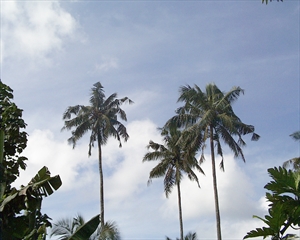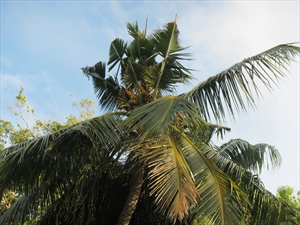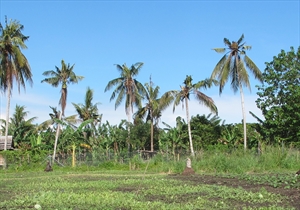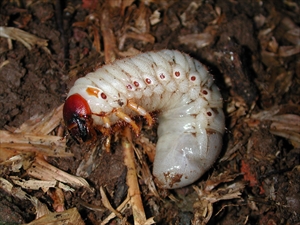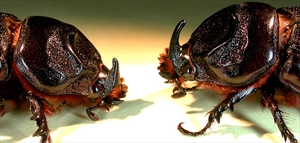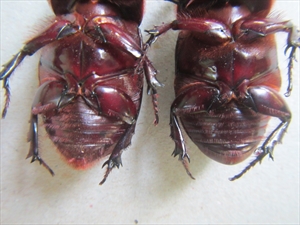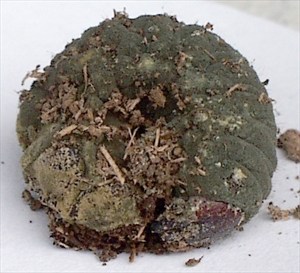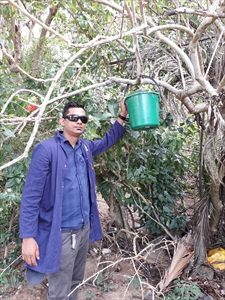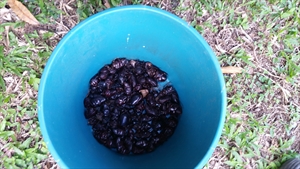Coconut rhinoceros beetle, rhinoceros beetle
Pacific Pests, Pathogens and Weeds - Online edition
Pacific Pests, Pathogens & Weeds
Coconut rhinoceros beetle - Oryctes (108)
Oryctes rhinoceros. Several strains are recognised. In Pacific islands
South and Southeast Asia, Oceania. American Samoa, Fiji, Hawaii, Papua New Guinea, Samoa, Solomon Islands, Tokelau, Tonga, Tuvalu, and Wallis & Futuna. Recently, the beetle has spread to Guam, Hawaii, mainland Papua New Guinea, Solomon Islands, and Vanuatu (under eradication).
Coconut is the most important host, but other palm species are attacked, including betel nut, sago palm and oil palm. Banana, Pandanus, sugarcane and tree fern are also hosts.
The adult beetle does the damage, boring into the crown of coconut palms, cutting across young fronds and flowers. When the leaves unfold the damage is seen as V or wedge-shaped areas missing from the leaflets (Photos 1-4). Holes in the base of the fronds may be obvious when beetle populations are high (Photo 5).
Oval eggs (3.5 x 4 mm) are laid one at a time, 5-15 cm, below the surface of moist organic materials, such as sawdust, manure, compost and garbage heaps, or above ground in tunnels, debris in axils of coconut fronds, in still-standing but dead and rotten coconut palms, and in the rotten ends of fallen coconut trunks (Photo 6). Logs and stumps of many other kinds of trees are also hosts (Photo 7). The eggs hatch in 8-12 days. The C-shaped larvae or grubs are white then creamy with brown heads (Photo 8). There are three stages lasting 80 to 200 days (depending on quality of the diet), with the third stage up to 100 mm long and 20 mm diameter. The last stage makes a hollow where it feeds, lining it with liquid faecal material, and then pupates. The two pupal stages last 25-40 days.
Adults remain in the ground for 2-3 weeks and then chew their way out. They are black with horns - those of the female often shorter than the male (Photos 9-12). Females live about 9 months, and lay about 50 eggs; males live about 5 months. The beetles are nocturnal, flying to the tops of coconuts where they use their mandibles, horn and strong forelegs to tunnel into the crowns. They do not eat the frass from the tunnels; instead, they drink the sap that comes from tunnelling.
Spread is on the wing, they are stronger flyers, and aboard ships and aircraft. They are attracted to lights.
The damage caused by the beetle results in loss of leaf area, flowers dying, early nut fall and, ultimately, lower yields. Occasionally, the beetles bore through the midribs of fronds, which snap in the wind.
It is difficult to relate damage to lost production. One way is to prune leaves to simulate beetle attack and compare nut yields on healthy palms. Using the relationship between damage and yield calculated elsewhere, work in Samoa showed that a 25% reduction in leaf area resulted in a 25% reduction in nut yield.
Indirect damage also occurs. In Asia and parts of Papua New Guinea, Oryctes attack encourages invasion by Rhynchophorus sp. palm weevils (see Fact Sheet no. 180).
Look for large jet-black beetles up to 40 mm long with prominent horns. Look for tunnels in the crown of coconut palms with frass - often more than one per palm. Look for the V-shape damaged fronds. Use a hooked wire inserted into the tunnel to remove the beetle. Differences between the strains depends on molecular tests.
Research into management of Oryctes started in the Pacific islands in the 1960s. Today, the key agent is a virus (Oryctes rhinoceros nudivirus - OrNV) originally from Malaysia. A fungus, Metarhizium anisopliae, from the Philippines is also used. Apply control measures if 3-5 beetles occur per ha up to 2 years after planting, and 15-20 beetles per ha thereafter.
BIOSECURITY
Vigilance is needed at seaports and airports against hitchhiking beetles. Establish pheromone traps and regularly inspect coconut palms growing nearby for frass and leaf symptoms. This is particularly important as new strains of the beetle have been found in Pacific islands in recent years, in addition to the original strain, CRB-S (also known as CRB-P), that has been present for more than 100 years. CRB-G is now present in Guam, Palau, Papua New Guinea, and Solomon Islands, and CRB-PNG in the islands of Papua New Guinea, Samoa, and Solomon Islands. The damage of all the strains is similar, but there has been speculation that CRB-G is tolerant to OrNV.
The FAO/IBPGR Technical Guidelines for the Safe Movement of Coconut Germplasm should be followed when coconut germplasm is transferred between countries (http://www.bioversityinternational.org/e-library/publications/detail/coconut/).
NATURAL ENEMIES
There are many general predators (pigs, rats, ants and other insects) and scoliid wasp parasites (e.g., Scolia ruficornis ). The nudivirus infects larvae and adults. It was released in Fiji, Samoa and Tonga in the late '60s and early '70s. Adult beetles are dipped in a suspension of ground, infected grubs, and then released to infect grubs in breeding sites, and adults in feeding tunnels. In Guam, spores of Metarhizium anisopliae (imported from the Philippines) are dusted onto beetles, which then contaminate larvae (Photo 13), and other beetles in breeding sites.
CULTURAL CONTROL
- Destroy fallen dead palms (split, allow to dry and burn); compost dead leaves and grass; and turn manure and sawdust heaps regularly and remove the grubs. Treat compost and manure with Metarhizium or insecticides. Note, in Samoa, the cutting of recently dead trunks has been questioned as a policy: the standing dead palms are (i) a valuable source of Oryctes rhinoceros nudivirus, and (ii) can be processed for fence posts, and other uses.
- Catch adults by covering breeding sites - heaps of fronds or other organic matter - with gill nets (Photo 14); the beetles get caught in the gill net when entering or leaving the breeding site. A method developed at the University of Guam.
- Catch adults with pheromone (ethyl 4-methyloctanoate) attached to bucket traps (15-17) spaced at 1-2 km (at beetle 'hot-spots'). Traps should be inspected at about every 3 month, beetles removed, and reloaded with pheromone.
- Make artificial breeding sites coconut logs containing organic material (chicken manure, sawdust, rotting coconut fibre, oil palm bunches) and laced with spores of Metarrhizium anisopliae.
- Grow a legume ground cover (e.g., Pueraria phaseoloides) over logs or stumps, and other potential breeding sites that cannot be destroyed easily. Note, that in Solomon Islands such covers did not prevent large infestations establishing in windrowed oil palms.
- Use a hooked wire to extract and destroy adult beetles feeding in the crowns of palms.
CHEMICAL CONTROL
Chemical control is not recommended: it is uneconomical because of the low value of coconuts per unit area; additionally, it is impractical to apply insecticides except to young palms. If insecticides are needed, use synthetic pyrethroids. Traps with the attractant ethyl 4-methyloctanoate have been used to monitor populations and to give economic control in some countries. Use one trap per 2 ha.
____________________
When using a pesticide, always wear protective clothing and follow the instructions on the product label, such as dosage, timing of application, and pre-harvest interval. Recommendations will vary with the crop and system of cultivation. Expert advice on the most appropriate pesticides to use should always be sought from local agricultural authorities.
AUTHOR Grahame Jackson
Information from Waterhouse DF, Norris KR (1987) Oryctes rhinoceros (Linnaeus). Biological Control Pacific Prospects. Inkata Press, Melbourne; and Mark Schmaedick (2005). Coconut rhinoceros beetle. Pests and diseases of American Samoa, Number 8. American Samoa College Community & Natural Resources Cooperative Research & Extension. (https://www.ctahr.hawaii.edu/adap/ASCC_Landgrant/Dr_Brooks/BrochureNo8.pdf); and from USDA APHIS (undated) Coconut rhinoceros beetle. Hungry Pests. (https://www.aphis.usda.gov/aphis/resources/pests-diseases/hungry-pests/the-threat/coconut-rhinoceros-beetle/hp-crp). Photos 7-13 Mark Schmaedick, Land Grant Program, American Samoa Community College. Photos 2,4,5 Joel Miles, Bureau of Agriculture, Republic of Palau. Photo 14 Aubrey Moore University of Guam. Photos 6&15-18 Nitya Singh, Ministry of Agriculture, Fiji.
Produced with support from the Australian Centre for International Agricultural Research under project PC/2010/090: Strengthening integrated crop management research in the Pacific Islands in support of sustainable intensification of high-value crop production, implemented by the University of Queensland and the Secretariat of the Pacific Community.
